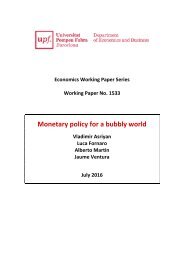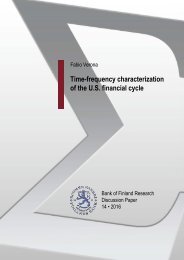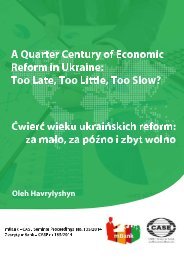Necessity as the mother of invention monetary policy after the crisis
n?u=RePEc:dnb:dnbwpp:525&r=mac
n?u=RePEc:dnb:dnbwpp:525&r=mac
Create successful ePaper yourself
Turn your PDF publications into a flip-book with our unique Google optimized e-Paper software.
Figure 6. Types <strong>of</strong> forward guidance used in recent years (Vertical axis denotes % <strong>of</strong><br />
responding central bank heads).<br />
Notes: B<strong>as</strong>ed on replies <strong>of</strong> 24 governors whose central bank used forward guidance. Multiple<br />
answers were possible, and a total <strong>of</strong> 35 answers were received. Source: Authors’ calculations b<strong>as</strong>ed<br />
on survey conducted in 2016.<br />
A second issue is whe<strong>the</strong>r FG changed how markets respond to macro news. Under<br />
calendar-b<strong>as</strong>ed FG, markets should give less emph<strong>as</strong>is to <strong>the</strong> flow <strong>of</strong> macroeconomic news<br />
than o<strong>the</strong>rwise. In line with this notion, Swanson and Williams (2014) and Feroli et al.<br />
(2016) find that <strong>the</strong> responses <strong>of</strong> medium- and long-term yields to macroeconomic<br />
announcements were muted once <strong>the</strong> Federal Reserve’s FG w<strong>as</strong> in place.<br />
To summarize, <strong>the</strong>re seems to be more evidence pointing to FG being effective than not.<br />
However, it is important to note that <strong>the</strong> various empirical studies are subject to substantial<br />
identification problems. Even event studies are contaminated by <strong>the</strong> fact that FG w<strong>as</strong><br />
typically used in conjunction with o<strong>the</strong>r UMPs. Fur<strong>the</strong>rmore, even if we conclude that FG<br />
h<strong>as</strong> been effective, it w<strong>as</strong> not without problems. Notably, FG had to be adapted over time<br />
in most circumstances, e.g. by moving from calendar-b<strong>as</strong>ed to data-b<strong>as</strong>ed FG, or by<br />
broadening <strong>the</strong> data-b<strong>as</strong>ed criteria. It is <strong>the</strong>refore important to <strong>as</strong>sess <strong>the</strong> pros and cons <strong>of</strong><br />
<strong>the</strong> different types <strong>of</strong> forward guidance.<br />
Feroli et al. (2016) provide a critical discussion <strong>of</strong> calendar-b<strong>as</strong>ed FG. While <strong>the</strong> muted<br />
market responsiveness to news under calendar-b<strong>as</strong>ed FG suggests that FG w<strong>as</strong> credible, it<br />
also implies that market conditions did not e<strong>as</strong>e in response to negative news, which<br />
hampered <strong>the</strong> accommodation <strong>of</strong> negative shocks. However, by <strong>the</strong> same token, positive<br />
macro news would not lead to premature and unwarranted tightening. More generally,<br />
calendar-b<strong>as</strong>ed FG can put a central bank in a quandary when economic developments<br />
change in an unexpected manner. In such c<strong>as</strong>es, <strong>the</strong> bank must choose between sticking<br />
with its earlier guidance, which may no longer be appropriate, or changing course, with<br />
29








